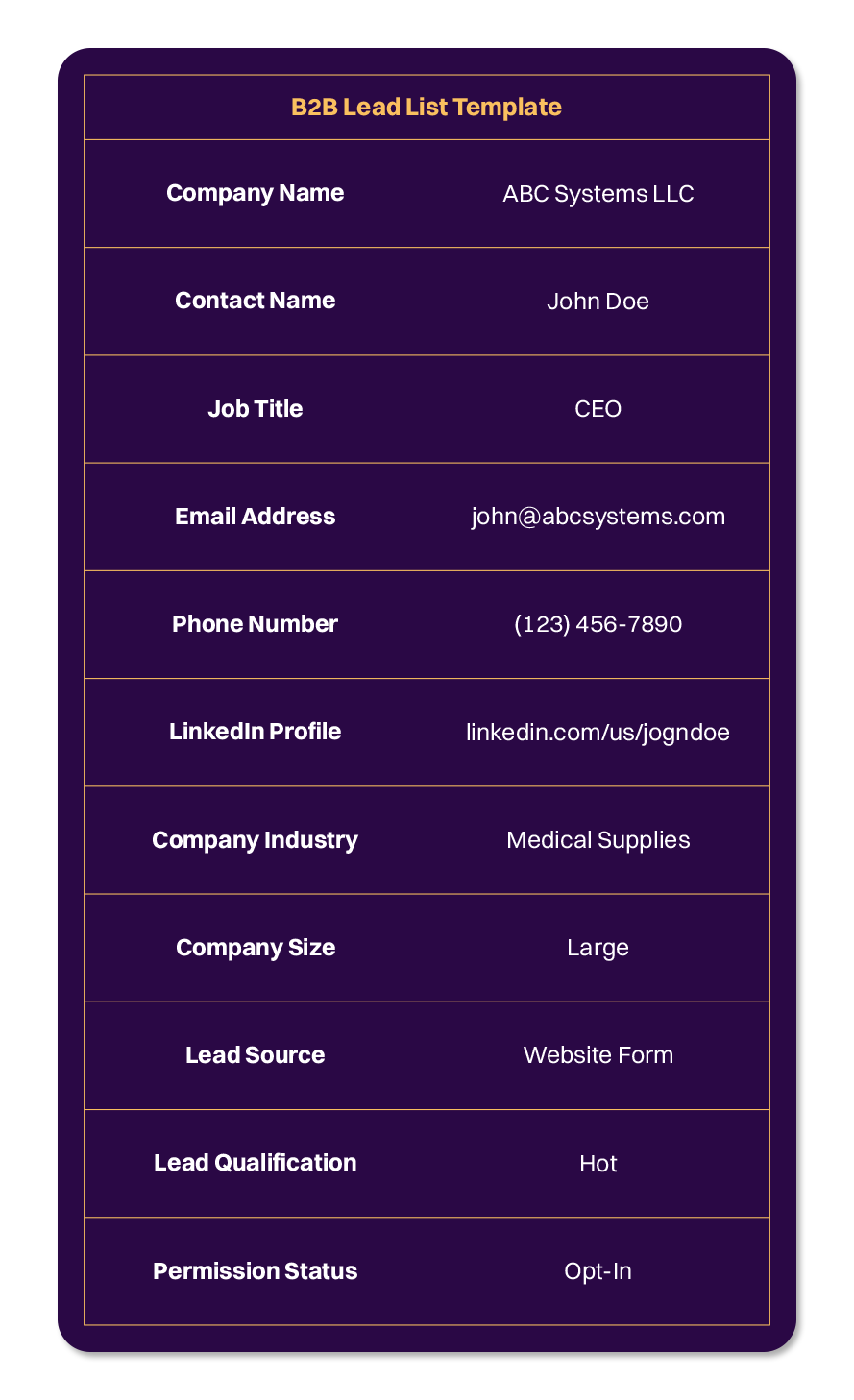
What Is a B2B Lead List: Your Key to Targeted Outreach
Are you tired of broadly casting your marketing net, hoping to snag potential B2B clients? Well, Google found that a staggering 56% of ad impressions never even register with consumers.
Yes, a massive chunk of your marketing budget is lost to the digital abyss. But stress not; to address this, let’s introduce you to a groundbreaking tool – B2B lead lists.
In this digital age, precision is critical. And B2B lead lists are your trump card for targeted outreach. They're not just lists; they're finely-tuned collections of potential clients who are already interested in your offerings.
Let's now explore the world of B2B lead lists – from what they are to why they're crucial.
What Is a B2B Lead List?
A B2B lead list is a comprehensive data list of your potential target clients carefully curated with professional details like their name, email, phone number, LinkedIn profile, company name, etc.
Businesses can use a B2B lead list to save time and resources by targeting the right audience with their marketing campaigns, ultimately increasing sales and revenue.
Adding to this, Matthew Ramirez (Entrepreneur and Investor) says:
"A B2B lead list can be seen as a comprehensive collection of contacts within a company who have willingly opted to participate in your marketing endeavors. With each campaign you execute, you are effectively generating potential leads.
These contacts have authorized you to connect with them once more, and you can utilize these datasets to identify and target your ideal customer precisely."
How Does A Lead List Differ from Other Marketing Lists?
Specificity sets a B2B lead list apart from generic marketing lists. While other lists might cast a wide net, a B2B lead list is like a laser-guided missile.
It's tailored to your exact needs and goals – leading to highly targeted outreach efforts. Why? You're not just adding any business or contact you stumble upon; you're being selective.
For instance, let's assume you're in the business of selling high-end software solutions to Fortune 500 companies. In such a case, your B2B lead list will include something other than mom-and-pop stores or small startups.
By focusing your efforts on leads that perfectly align with your ideal customer profiles, you'll see higher conversion rates and, hence, a significant boost in ROI.
Tailoring your messaging and solutions to the specific needs of these leads is the reason behind increased sales and revenue.
What Are the Key Elements of B2B Lead Lists?
A B2B lead list is more than a compilation of names and contact details; it's a strategic asset. Here's a breakdown of its key components:
- Contact Information: Names, email addresses, phone numbers, mailing addresses, and sometimes social media profiles.
- Company Information: Data about the companies these individuals represent, including their industry, size, location, and more.
- Demographic and Firmographic Data: Additional information about leads, such as job titles, roles, company revenue, and other relevant data.
- Lead Source: Data about where each lead originated – whether from website forms, trade shows, social media, or other sources.
- Lead Qualification: The categorization of leads: "hot," "warm," or "cold" – based on their readiness to buy.
- Permission Status: Information on whether leads have consented to be contacted – especially in CAN-SPAM Act compliance with data privacy regulations and GDPR.
B2B Lead List Template

What Are the 3 Primary Types of B2B Lead Lists?
Regarding B2B lead lists, one size does not fit all. As David Reid, Sales Director of VEM Tooling, reiterates:
“I've always believed that the actual value of a lead list lies in the relationships you build from it. In a world inundated with information, the personal touch, the tailored message, and the genuine connection turn a lead into a valued customer.”
Yes, depending on your specific business goals and target audience, you can choose from various lists catering to different aspects of your marketing strategy.
1. Industry-Specific Lead Lists
- Definition: These lists are tailored to a particular industry or niche. They include businesses and contacts within that specific sector.
- Example: Say you're a software company specializing in healthcare solutions. An industry-specific lead list would exclusively feature healthcare organizations, hospitals, and professionals.
- Benefits: Industry-specific lists allow you to focus on a niche market where your product or service is most relevant. Hence, it increases the chances of finding prospects genuinely interested in what you offer.
2. Geographic Lead Lists
- Definition: These lists are organized based on geographical location. They can be as broad as a country or as narrow as a city or postal code.
- Example: If you're a real estate agent in New York, a geographic lead list could include potential property buyers and sellers specifically in the New York City area.
- Benefits: Geographic lists help you target prospects within your operational area.
3. Role-Based Lead Lists
- Definition: Role-based lists categorize leads based on their job titles or organizational roles.
- Example: If you sell HR software, a role-based list might include HR managers, directors of human resources, or chief people officers.
- Benefits: Role-based lists allow you to direct your marketing efforts toward decision-makers with the authority to make purchasing decisions. It ensures your message reaches those who can say "yes."
How Can You Create or Access B2B Lead Lists?
Let's go through the approaches to generate or outsource your B2B lead lists:
1. Building Your Own Lead List
Curating your organizational lead lists requires a strategic approach. It involves creating a systematic plan to identify and collect potential leads' contact information.
It includes tactics such as website forms, content downloads, webinars, and networking events. These strategies help organically grow a list tailored to your business's specific needs.
Creating lists requires more time – true. Yet, it provides increased authority over data excellence and precision. Thus, it guarantees that the designated contacts have displayed a genuine interest in your enterprise.
Insights for Curating Effective B2B Lead Lists In-House
Here are some unique inputs to maximize the potential of your in-house B2B lead list:
- Quality over Quantity: A smaller, well-researched list aligned with your ideal customer profile yields (ICP) better results. In fact, a list of 100 potential clients that fit your ICP can be more valuable than a list of 10,000 random companies.
- Data Enrichment: Use AI tools like ZoomInfo or Clearbit to add valuable details like job titles, recent company news, or social media profiles.
- Segmentation is Key: Divide your list by industry, company size, or pain points for personalized messaging.
- Regular Cleaning: Remove duplicates and outdated contacts to target active prospects.
- Legal Compliance: Stay updated with data privacy laws like GDPR and CCPA to avoid fines.
- Automation: Use tools like HubSpot or Marketo to track lead interactions, score leads, and prioritize follow-ups.
- Integration: Seamlessly integrate your lead list with your CRM to enhance collaboration and avoid data silos.
- Feedback Loop: Create communication between sales and marketing for better targeting.
- Content Alignment: Tailor your messaging to address specific industry pain points.
- Testing and Iteration: A/B test your outreach strategies to find what resonates best with your audience.
Finally, involve your sales and marketing teams. As Anna Nielsen, Marketing Director at OGLF, explains:
“Your marketing and sales team should be the ones getting down and dirty with the lead list. And that's why it's crucial only to include leads that fit your business objectives. You should strategize how to turn these leads into actual revenue.”
2. Exploring Reputed List-Providing Partners
Third-party lead list providers offer a convenient solution if you want to acquire pre-compiled lists of potential leads. They source, verify, and segment leads based on various criteria.
By leveraging their expertise and resources, you can access high-quality lists quickly. However, you MUST evaluate such providers carefully to ensure the lists align with your target audience.
PRO TIP: Consider liaising with providers specializing in generating BOTH lead and prospect lists. With this dual expertise, you’ll make your outsourcing process more efficient and cost-effective.
Key Considerations for Choosing a Lead List Provider
Selecting the right lead list provider is critical to the success of your outreach efforts. Considerations include the following aspects:
1. Reputation and experience
2. Data accuracy measures
3. Compliance with data privacy regulations
4. Pricing structure
5. Ability to customize lists according to your criteria
Final Word
Now that you understand the significance of B2B lead lists, you can get ready to turbocharge your marketing endeavors. However, if you need a reputed B2B list-building partner to find the perfect leads tailored to your unique products or services, you can check out Revnew.
Revnew’s mission is to connect you exclusively with qualified decision-makers genuinely interested in your offer. Their team owns massive amounts of data – from demographics to firmographics, technographics, and psychographics – all customized to provide you with the most precise prospect information.
Don't hesitate to contact us with any questions or for assistance. We're here to fuel your journey to success!




